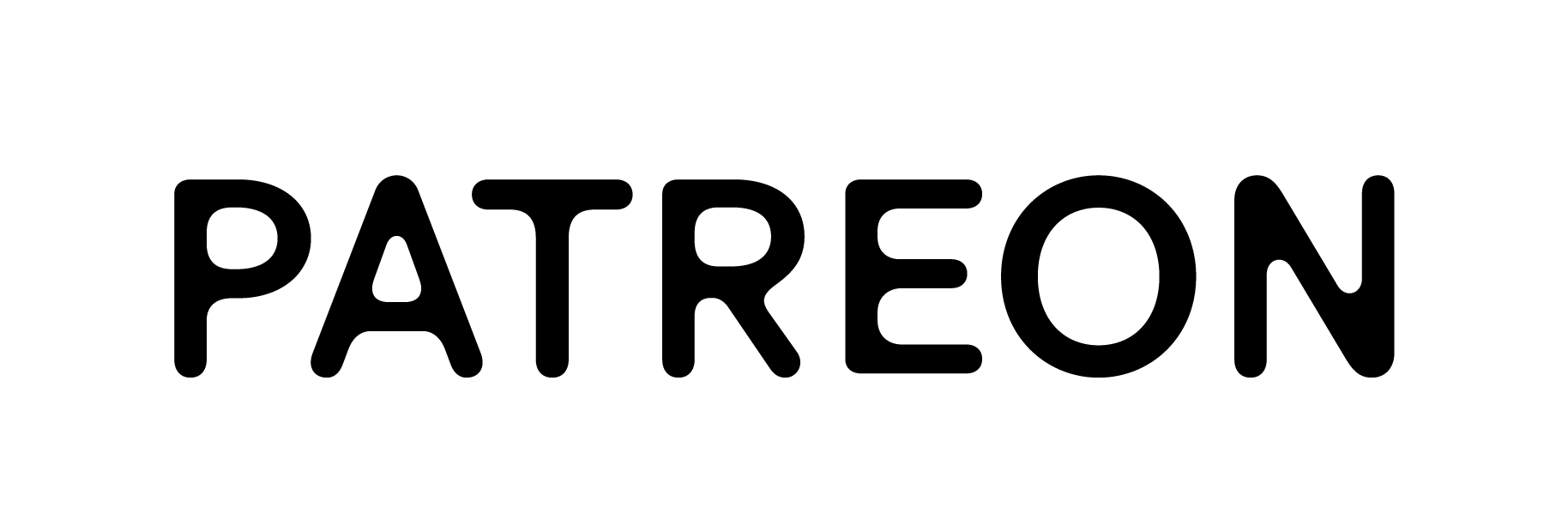How do I level my Ollie?
Leveling Ollie needs push of your front foot, weight distribution and the use of upper body.
Leveling Ollie requires much more than a simple pop of your back foot.
"Push the nose with your front foot." The action sounds simple, so why is it so hard? In fact, you can't simply push your front foot forward without paying attention to other elements of this trick, such as the movement of your back foot and weight distribution.
Let's scientifically break down the elements needed to level the board.
Summary
Why can I not push my board to level out my Ollie?
You could be holding down the tail of your board and giving the nose too much energy that could block your front foot to level out your board effectively.
How do I level out my Ollie?
Before pushing your front foot, make sure to have your body weight going up and releasing the pressure on the tail of your board. The use of your front foot comes only after that.
How do I pull up my back foot?
Use your upper body to lift your entire body weight. But make sure not to overextend your upper body. Lowering your upper body at the peak of your Ollie allows you to utilize the energy of "reaction" to lift your foot more efficiently.
Simulation
Why can you NOT push your front foot?
You can't push your board while pressurizing the tail
First of all, when you want to push the nose, your board must be able to move freely, so to speak, in a state of free-floating. And it can't move no matter how hard you try it if you pressurize it unnecessarily.

The harder you push down the tail, the heavier the nose becomes
For example, as a common problem, if you press the nose while your back foot is applying a force to pop down the tail, your can't move your board. This is because the energy the nose receives increases proportionately to the power you apply to the tail. In other words, the harder you push down the tail, the heavier the nose becomes WHILE your back foot is on the tail.
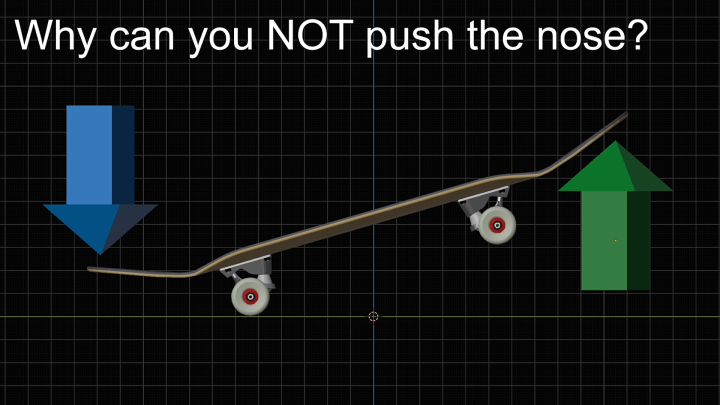
Front foot can't generate as much energy as back foot does
So if you want to move your board when your back foot is pressing down the tail to lift your body weight, your front foot has to generate more energy than your back foot. But that is impossible; Your back foot generates significantly more power than your front foot as it can directly stomp down the ground using your body weight.
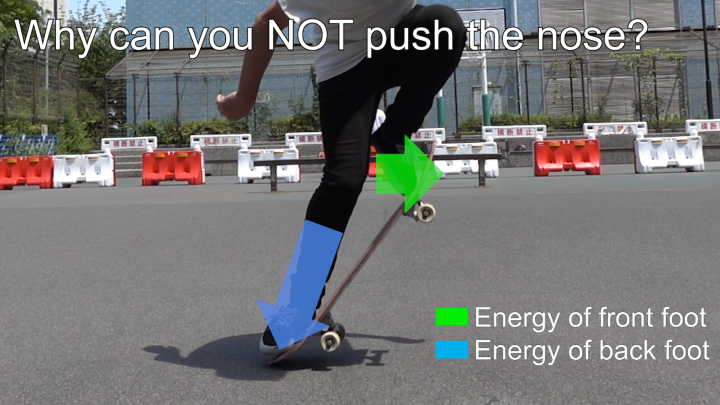
Jumping and popping
Lift body before lifting back foot
Due to the said reasons, you need to have your back foot not pushing down the tail by the time you slide up your front foot. As you can't pull up your back foot when your body is standing still, you first have to have your body weight going up before pulling up your back foot.
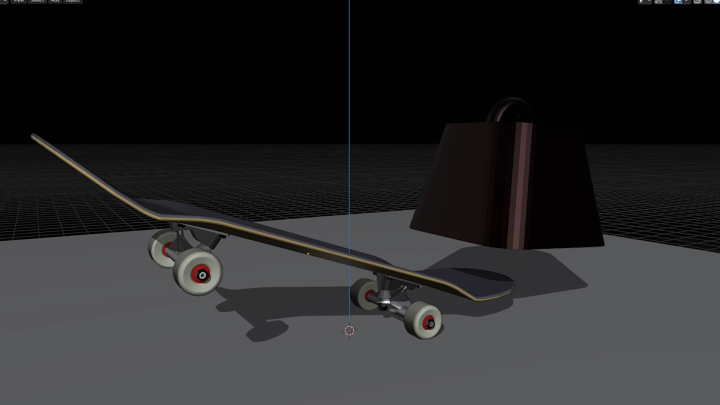
How to lift body weight
Use both of your thighs and focus on pushing your board evenly. As I said in the previous content, your board stays horizontally flat because you will be exerting the downward force on both of your feet evenly. While jumping is to bring your body weight upward. It is essential to understand this action is different from popping.
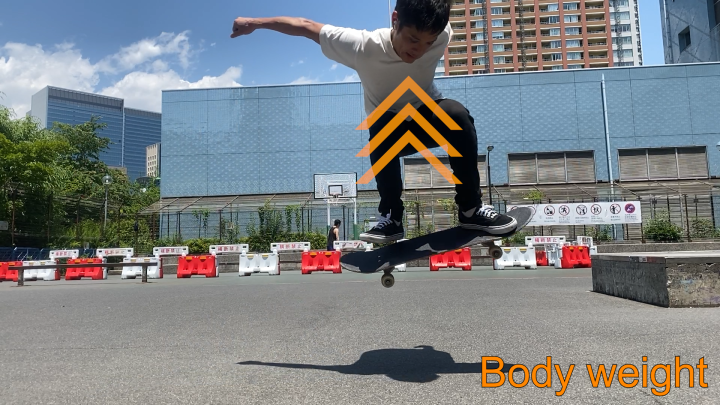
Difference between popping and jumping
Popping is an action of hitting the tail against the ground using the movement of your ankle after having your body in the air. Without understanding this difference, you might kick down the tail with your entire leg. Then your back foot will remain on the tail unnecessarily longer as your body stays low.
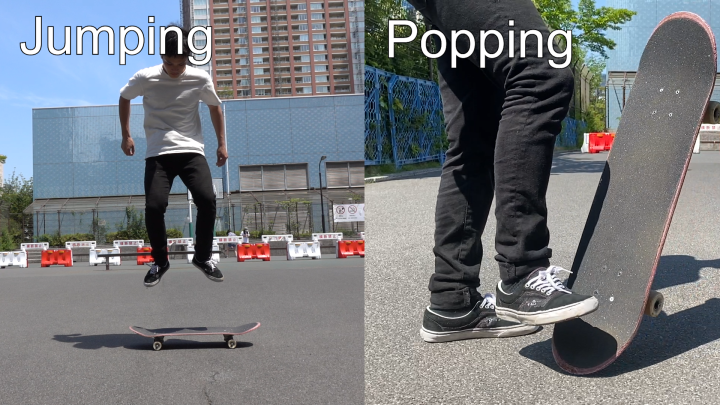
Energy efficiency
Once again, you can't push the nose no matter how you use your front foot while pressing down the tail. So make sure to lift your body weight first and give the tail of your board a snap of your ankle. This way, you can bring up your back foot easier.

The use of upper body
Key concept: Conservation of energy
The role of the upper body doesn't end here; after getting in the air, it also determines how easily you can pull up your back foot. The point is the "conservation of energy" applies here, too. Gosh, I used to hate this back when I was a student.
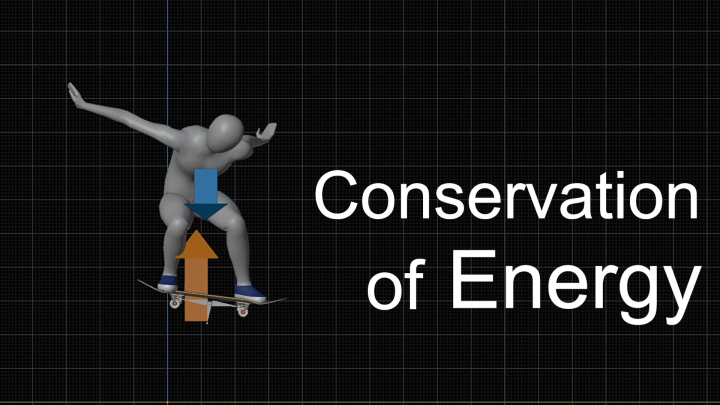
Downside of jumping up too high
A common mistake is lifting your upper body too much or jumping up too high. Understandably, you might think you should jump up as high as possible. But that could be why you can't lift your back foot.

Basic concept of "reaction"
In order to understand why you should avoid jumping up too high, let's first imagine what happens when you are trying to reach higher. You'd kick down the ground as hard as possible.
And after getting into the air, you'd have to extend your lower body to raise your upper body higher. This way, you can harness the momentum of the reaction; As your lower body goes lower, your upper body tries to offset the energy by going in the other direction.
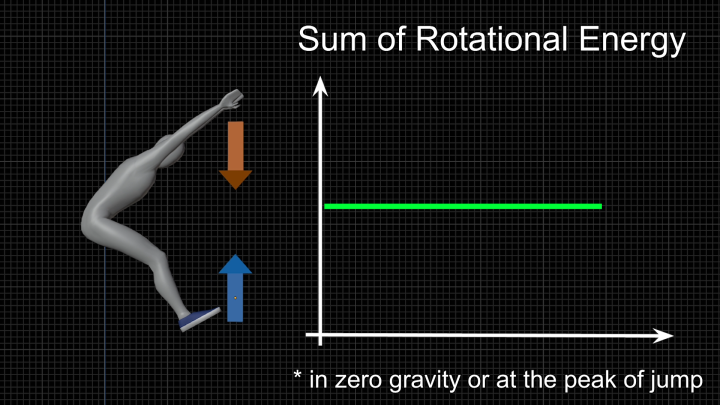
How to apply the concept of "reaction" to an Ollie
A similar thing can happen in an Ollie, too. It may be counterintuitive, but if you want to lift your back foot higher, lowering your upper body might help.
Theoretically, when one side of an object moves in the air, the other side moves in the other direction to conserve the sum of the object's energy. To apply this concept in an Ollie, you want to lower your upper body and lift your back foot in a way that you compress your body at the peak of your Ollie.
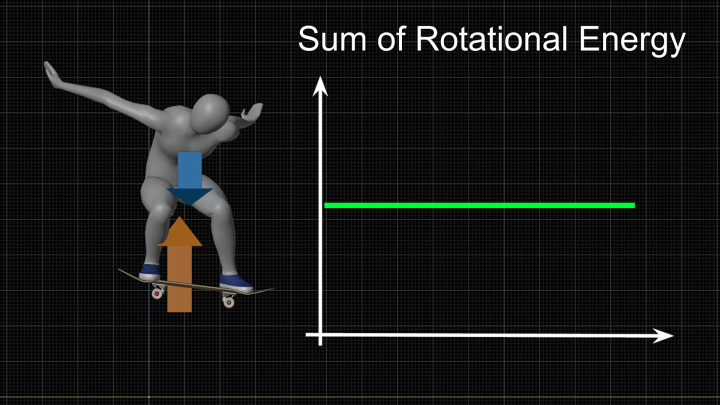
Overextending your body lifts your front foot too high
Furthermore, you can tell that you can't push the nose of your board when you jump up too high if you think about it this way; When you jump up too high and extend your body, your body brings up your front foot with it. In other words, while you are trying to push your front foot forward, your body's momentum pulls it in the other direction. This is also why you should avoid overextending your body.
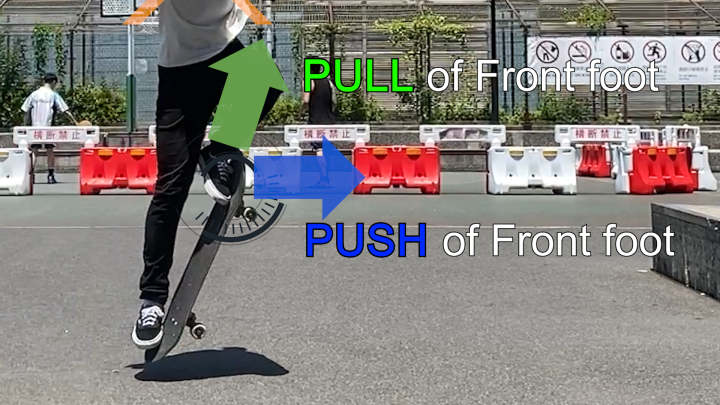
Lower your body if you want to go higher
So, to lift your back foot effectively, think about it this way; You may kick down the ground as hard as possible. But avoid letting your upper body go higher than the height you started. And gradually start lowering it as your Ollie gets closer to its peak, which allows you to harness your upper body's reaction and lift your back foot efficiently.
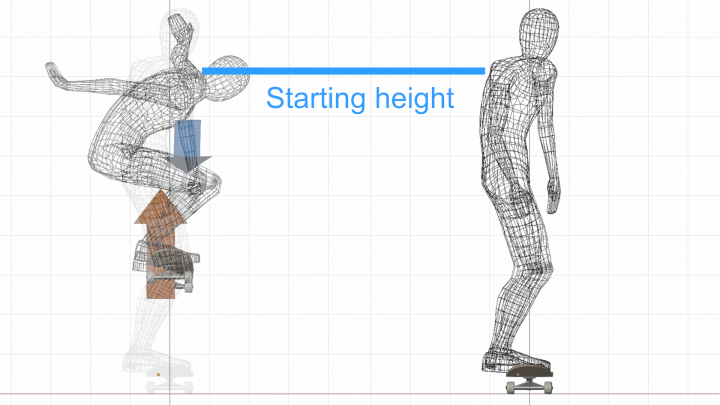
The use of feet
Direction of push
With all that ready, it's finally time to move your feet. Push your front foot in the direction you are going, NOT to the toe side. Pushing your board to the toe side turns your board and makes you lose your balance.
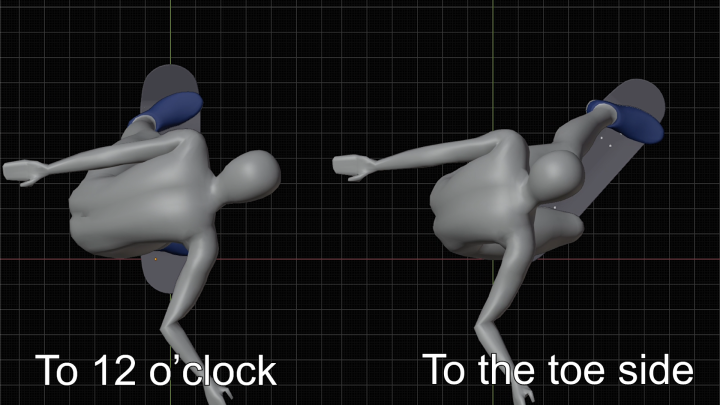
Turn back leg inward
Although you must practice extending your front foot, you also have to pay attention to your back foot because your board can not move as long as your back foot blocks its movement.
Try turning your back foot inward to avoid letting it block your board's movement. It is easy for a human leg to bend inward like you naturally do when sitting on the ground.
So if you think you can't push your board forward even when trying to, make sure your back foot is NOT blocking its movement. And if it is, try turning it inward.

Landing
Options to getting back on your board
Given you could push your board forward, how do you land back on it? You will land outside your board as your body's center of gravity and your board are not aligned when you push your board forward. Theoretically, there are two options.
- Pulling your board back underneath you.
- Sending your body forward over your board.
Of course, the 2nd option is impossible unless you can fly. So, eventually, you have to go for option #1. And that's when the previous step becomes the most important.

Additional plus side of turning back leg inward
According to the previous step, you should turn your back leg inward. Doing so generates tension outside your leg. Your back foot will naturally return to the neutral position as you release such tension outside your leg, which helps you bring your board under your feet.
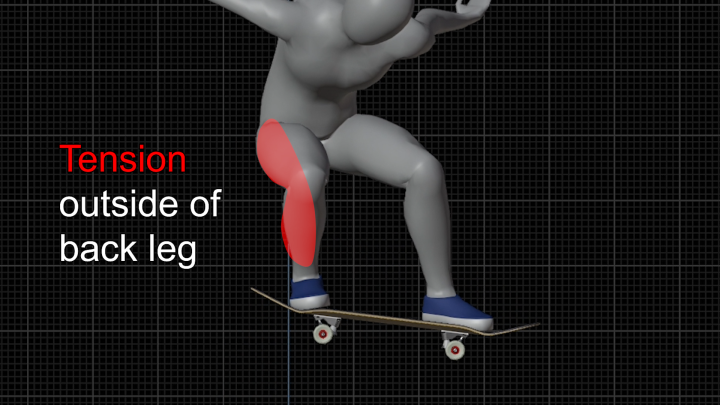
Keep your body axis vertical
Keep in mind that you should NOT tilt your body axis. If you push your board forward by leaning backward, you won't be able to get back on your board. Because once tilted, the axis will continue tilting in the same direction due to inertia. So always make sure to keep your body axis straight upward.
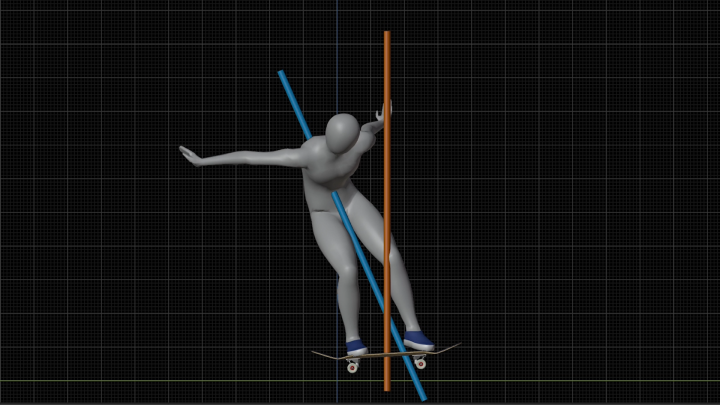


 Convert your video into 3D
Convert your video into 3D Facebook
Facebook Twitter
Twitter



